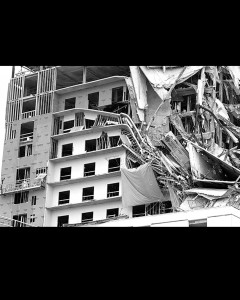New Orleans incurring millions in costs for Hard Rock and Cybersecurity disasters, but officials hope the bulk will be reimbursed
10th February 2020 · 0 Comments
By Michael Isaac Stein
The Lens
New Orleans has experienced two major disasters in the past few months: the collapse of the partially built Hard Rock Hotel on Oct. 12, and a cyber attack on Dec. 13 that continues to cripple everyday city services. The two issues are not only disruptive, they are expensive, officials told the New Orleans City Council’s Budget Committee on February 4.
According to Mayor LaToya Cantrell’s top deputy, Chief Administrative Officer Gilbert Montaño, the cyberattack will cost the city at least $7.1 million.
Estimated costs from the Hard Rock collapse came to $11.7 million by the end of 2019. That includes about $4.8 million in costs and lost revenue for the Regional Transit Authority, which had to reroute its buses around the disaster site.
But Montaño told the council that the city plans to get the bulk of the costs for both incidents reimbursed through their cybersecurity insurance, the Hard Rock developers’ insurance and, if necessary, through litigation with the Hard Rock developers if the insurance payments don’t cover everything.
“This will at some point will be handled by a court,” Montaño said. “The city should not bear those costs and we have no plan to bear those costs.”
The biggest costs associated with the Hard Rock collapse are related to public transportation. According to Montaño’s presentation, the collapse has cost the Regional Transit Authority $1.6 million in lost bus and streetcar fares and $3.2 million in costs associated with changes to transit operations, including setting up alternative bus routes to avoid the collapse site.
Other costs include just over $2 million in estimated repairs to streets, drainage and other public infrastructure, $928,000 for a “firewatch” at the site and $2.2 million for “public safety, leadership and support payroll.” Repairs to the roof of the Saenger theater are estimated at $750,000.
“This doesn’t include the impact on the local economy,” Montaño said. “These are our hard costs.” (The presentation did, however, include $100,000 in estimated lost revenue to the Saenger, which had to cancel performances of the musical “Wicked” after the collapse.)
City Councilman Jared Brossett asked if the city was trying to track and measure the economic impact of the collapse for future claims. Montaño said it was not, but that it was encouraging businesses to keep track and share that information with the city. The city also reached out to the Hard Rock corporate offices to see if they wanted to pitch in funds to help struggling businesses that have been stymied by the collapse and continuing road closures. A proposed class-action suit against the developers on behalf of businesses, property owners and workers affected by the collapse and subsequent street closures is ongoing.
Montaño said the city never got a response from Hard Rock International USA Inc., which was part of a licensing agreement but not involved in the construction or the development of the site.
The development team — 1031 Canal Street Development LLC — is led by Mohan Kailas and made up of local companies.
The cybersecurity attack, meanwhile, has already cost the city $3 million to clean computers, get city emails up and running and pay overtime to the city’s IT staff. According to the presentation, the city expects to spend another $4 million on the recovery going forward. Those costs will include replacing outdated equipment, new security tools and “cybersecurity team staffing.”
The city has a cyberattack liability insurance policy that will allow it to recover $3 million out of the total $7 million in expected costs. Montaño said that the city is now beefing up its cyberattack insurance policy. He declined to share how much coverage the city was getting — Cantrell previously said the plan was to increase it to $10 million — nor would he give an estimate on premium increases.
Councilwoman Kristin Palmer asked how the recovery was going, saying she was particularly worried about the Department of Safety and Permits, which approves building permits and handles city inspections.
“People are very concerned,” she said. “These people are wasting entire days at City Hall when they have plumbers, electricians, etc. waiting on the job.”
Montaño said that the restoring the Department of Safety and Permits, as well as the city’s online permitting website, the One Stop Shop, was a central priority for the administration. But, he said, he didn’t want to “blow the bank” on overtime. He said he had to balance cost versus speed of recovery.
“The priority has to be having our systems available,” he said.
The above article originally appeared in The Lens on its website (www.thelensnola.org). The Louisiana Weekly enjoys a partnership with The Lens.
This article originally published in the February 10, 2019 print edition of The Louisiana Weekly newspaper.



